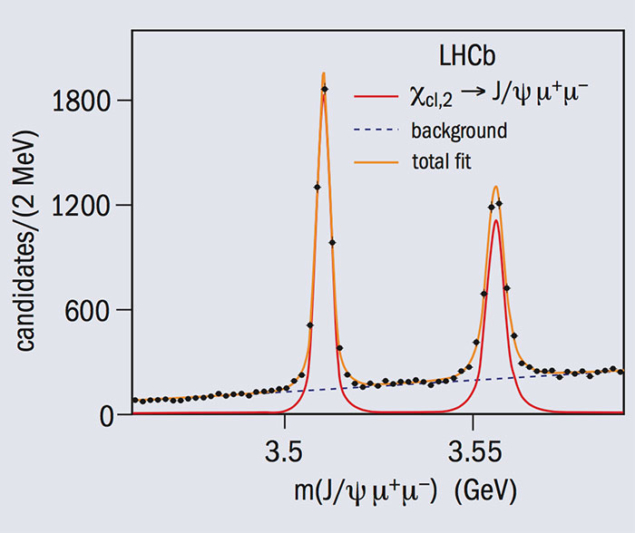

The LHCb collaboration has published the result of precision mass and width measurements of the χc1 and χc2 charmonium states, performed for the first time by using the newly discovered decays χc1 → J/ψ μ+μ– and χc2 → J/ψ μ+μ–. Previously it has not been possible to make precision measurements for these states at a particle collider due to the absence of a fully charged final state with a large enough decay rate, allowing powerful comparisons with results from earlier fixed-target experiments.
The dominant decay mode of such charmonium states is χc1,2 → J/ψ γ. However, the precision measurement of the energy of the final-state photon, γ, is experimentally very challenging, particularly in the harsh environment of a hadron collider such as the LHC. For this reason, such measurements were only possible at dedicated experiments that exploited antiproton beams annihilating into fixed hydrogen targets and forming prompt χc1 states. By modulating the energy of the impinging antiprotons, it was possible to scan the invariant mass of the states with high precision. But the obvious difficulties in building such dedicated facilities has meant that precision mass measurements were only performed by two experiments: E760 and E835 at Fermilab, the latter being an upgrade of the former.
In these new Dalitz decays, χc1,2 → J/ψ μ+μ–, where the J/ψ meson subsequently decays to another μ+μ– pair, the final state is composed of four charged muons. Thus these modes can be triggered and reconstructed very efficiently by the LHCb experiment. The high precision of the LHCb spectrometer already enabled several world-best mass measurements of heavy-flavour mesons and baryons to be performed, and now it has allowed the two narrow χc1 and χc2 peaks to be observed in the invariant J/ψ μ+μ– mass distribution with excellent resolution (see figure). The values of the masses of the two states, along with the natural width of the χc2, have been determined with a similar precision to, and in good agreement with, those obtained by E760 and E835.
This new measurement opens an avenue to precision studies of the properties of χc mesons at the LHC, more than 40 years since the discovery of the first charmonium state, the J/ψ meson. It will allow precise tests of production mechanisms of charmomium states down to zero transverse momentum, providing information hardly accessible using other experimental techniques. In addition to the charmonium system, these observations are expected to have important consequences for the wider field of hadron spectroscopy at the LHC. With larger data samples, studies of the Dalitz decays of other heavy-flavour states, such as the exotic X(3872) and bottomonium states, will become possible. In particular, measurements of the properties of the X(3872) via a Dalitz decay may help to elucidate the nature of this enigmatic particle.





